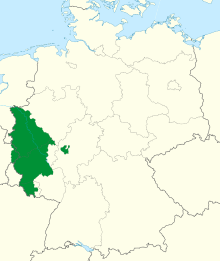Rhenish nationalism


Rhenish nationalism is the point of view that asserts that Rhinelanders are a nation and promotes the cultural unity of Rhinelanders.[1]
History
Rhenish nationalism first arose in the aftermath of Prussia's conquest of the Rhineland in the Napoleonic Wars and during the Revolutions of 1848.[1] In 1848–1849, Rhenish separatists fought against the Prussian army, but revolution in the Rhineland was put down by Prussian forces.[1] It emerged as an anti-Prussian mass movement by the late 19th century that called for the separation of Rhineland (that had become the Rhine province of Prussia) from Protestant-dominated Prussia.[1]

After the end of World War I and the collapse of the Prussian-led Hohenzollern dynasty of Germany in 1918, Rhenish nationalism and separatism surged.[1] Germany's Centre Party proposed a compromise whereby Germany would be reconstituted as a "German Federation" that would include a "Rhenish-Westphalian Republic" within it, ending Prussia's control over the territory.[1] In 1919, Rhenish separatists, supported by France, declared a Rhenish Republic; however, this republic soon fell to forces of the central German government later that year.[2] In 1923, again with French support, Rhenish separatists initiated a successful rebellion and created a new Rhenish Republic and proclaimed the Rhineland's independence from Germany.[2] The future Chancellor of West Germany, Konrad Adenauer, was a Rhenish nationalist and separatist during the 1923–1924 period in the Rhineland.[2] Civil unrest and opposition to the creation of the new state by the United States and the United Kingdom resulted in its collapse in 1924.[2] Rhenish nationalists were persecuted by the Nazi regime in Germany.[2] Rhenish separatists again received support from France in 1945, but did not achieve independence.[2]
In the postwar reorganization of German states, the Rhineland was divided among the new states of North Rhine–Westphalia, Rhineland–Palatinate and the Saarland, while the exclaved district of Wetzlar became part of Hesse. The districts of Eupen and Malmedy had been incorporated into Belgium in 1925.
In the 1990s, Rhenish autonomism reemerged, calling for greater autonomy for the Rhineland as a response to the unification of West and East Germany.[3] Concerns arose about issues concerning a less prosperous southern Rhineland being ignored by the German government while attention focused on the economic revival of newly incorporated East Germany.[3]
See also
References
- 1 2 3 4 5 6 James Minahan. Encyclopedia of the stateless nations. 3. L - R. Greenwood Publishing Group, 2002. P. 1581.
- 1 2 3 4 5 6 James Minahan. Encyclopedia of the stateless nations. 3. L - R. Greenwood Publishing Group, 2002. Pp. 1581–1585.
- 1 2 James Minahan. Encyclopedia of the stateless nations. 3. L - R. Greenwood Publishing Group, 2002. Pp. 1586.